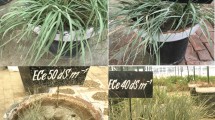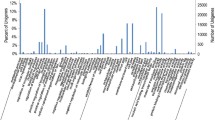Abstract
The response of a grass halophyte Spartina alterniflora at early stages of salt stress was investigated through generation and systematic analysis of expressed sequence tags (ESTs) from both leaf and root tissues. Random EST sequencing produced 1,227 quality ESTs, which were clustered into 127 contigs, and 368 were singletons. Of the 495 unigenes, 27% represented genes for stress response. Comparison of the 368 singletons against the Oryza sativa gene index showed that >85% of these genes had similarity with the rice unigenes. Moreover, the phylogenetic analysis of an EST similar to myo-inositol 1-phosphate synthase of Spartina and some selected grasses and halophytes showed closeness of Spartina with maize and rice. Transcript abundance analysis involving eight known genes of various metabolic pathways and nine transcription factor genes showed temporal and tissue-dependent variation in expression under salinity. Reverse northern analysis of a few selected unknown and ribosomal genes exhibited much higher abundance of transcripts in response to salt stress. The results provide evidence that, in addition to several unknown genes discovered in this study, genes involved in ion transport, osmolyte production, and house-keeping functions may play an important role in the primary responses to salt stress in this grass halophyte.






Similar content being viewed by others
References
Altschul SF, Madden TL, Schaffer AA, Zhang J, Zhang Z, Miller D, Lipman DJ (1997) Gapped BLAST and PSI–BLAST: a new generation of protein database search programs. Nucleic Acids Res 25:3389–3402
Ayala FO, Leary JW, Schumaker KS (1996) Increased vacuolar and plasma membrane H+-ATPase activities in Salicornia bigelovii Torr. in response to NaCl. J Exp Bot 47:25–32
Baisakh N, Subudhi PK, Parami NP (2006) cDNA–AFLP analysis reveals differential gene expression in response to salt stress in a halophyte Spartina alterniflora Loisel. Plant Sci 170:1141–1149
Berardini TZ, Mundodi S, Reiser R, Huala E, Garcia-Hernandez M, Zhang P, Mueller LM, Yoon J, Doyle A, Lander G, Moseyko N, Yoo D, Xu I, Zoeckler B, Montoya M, Miller N, Weems D, Rhee SY (2004) Functional annotation of the Arabidopsis genome using controlled vocabularies. Plant Physiol 135:1–11
Bohnert HJ, Gong Q, Li P, Ma S (2006) Unravelling abiotic stress tolerance mechanisms-getting genomics going. Curr Opin Plant Biol 9:180–188
Chung HJ, Ferl RJ (1999) Arabidopsis alcohol dehydrogenase expression in both shoots and roots is conditioned by root growth environment. Plant Physiol 121:429–436
Cushman JC, Bohnert HJ (2000) Genomics approaches to plant salt tolerance. Curr Opin Biotechnol 3:117–124
Das-Chatterjee A, Goswami L, Maitra S, Dastidar KG, Ray S, Majumder AL (2006) Introgression of a novel salt-tolerant l-myo-inositol 1-phosphate synthase from Porteresia coarctata (Roxb.) Tateoka (PcINO1) confers salt tolerance to evolutionary diverse organisms. FEBS Lett 580:3980–3988
Dolferus R, Jacobs M, Peacock WJ, Dennis ES (1994) Differential interactions of promoter elements in stress responses of the Arabidopsis Adh gene. Plant Physiol 105:1075–1087
Ewing B, Green P (1998) Base-calling of automated sequencer traces using Phred. II. Error probabilities. Genome Res 8:186–194
Feliciello I, Chinali G (1993) A modified alkaline lysis method for the preparation of highly purified plasmid DNA from Escherichia coli. Anal Biochem 212:394–401
Flowers TJ (2004) Improving crop salt tolerance. J Exp Bot 55:307–319
Hoagland DR, Arnon DI (1950) The water-culture method for growing plants without soil. Calif Agric Exp Stn Circ 347
Imai J, Yahara I (2000) Role of HSP90 in salt stress tolerance via stabilization and regulation of calcineurin. Mol Cell Biol 20:9262–9270
Inada M, Ueda A, Shi W, Takabe T (2005) A stress-inducible plasma membrane protein 3 (AcPMP3) in a monocotyledonous halophyte, Aneurolepidium chinense, regulates cellular Na+ and K+ accumulation under salt stress. Planta 220:395–402
Ishitani M, Majumder AL, Bornhouser A, Michalowski CB, Jensen RG, Bohnert HJ (1996) Coordinate transcriptional induction of myo-inositol metabolism during environmental stress. Plant J 9:537–548
Jeong MJ, Park SC, Byun MO (2001) Improvement of salt tolerance in transgenic potato plants by glyceraldehyde-3 phosphate dehydrogenase gene transfer. Mol Cells 12:185–189
Kawasaki S, Borchert C, Deyholos M, Wang H, Brazille S, Kawai K, Galbraith D, Bohnert HJ (2001) Gene expression profiles during the initial phase of salt stress in rice. Plant Cell 13:889–906
Liu D, Zhang X, Cheng Y, Takano T, Liu S (2006) rHsp90 gene expression in response to several environment stresses in rice (Oryza sativa L.). Plant Physiol Biochem 44:380–386
Low R, Rockel B, Kirsch M, Ratajczak R, Hortensteiner S, Martinoia E, Luttge U, Rausch T (1996) Early salt stress effects on the differential expression of vacuolar H+-ATPase genes in roots and leaves of Mesembryathemum crystallinum. Plant Physiol 110:259–265
Majumder AL, Chatterjee A, Ghosh Dastidar K, Majee M (2003) Diversification and evolution of l-myo inositol 1-phosphate synthase. FEBS Lett 553:3–10
McIntosh KB, Bonham-Smith PC (2005) The two ribosomal protein L23A genes are differentially transcribed in Arabidopsis thaliana. Genome 48:443–454
Mehta PA, Sivaprakash K, Parani M, Venkataraman G, Parida AK (2005) Generation and analysis of expressed sequence tags from the salt-tolerant mangrove species Avicennia marina (Forsk) Vierh. Theor Appl Genet 110:416–424
Mukhopadhyay A, Vij S, Tyagi A (2004) Overexpression of a zinc-finger protein gene from rice confers tolerance to cold, dehydration, and salt stress in transgenic tobacco. Proc Natl Acad Sci U S A 101:6309–6314
Nadal E, Zapater M, Alepuz PM, Sumoy L, Mas G, Posas F (2004) The MAPK Hog1 recruits Rpd3 histone deacetylase to activate osmoresponsive genes. Science 427:370–374
Nadeau K, Das A, Walsh CT (1993) Hsp90 chaperonins possess ATPase activity and bind heat shock transcription factors and peptidyl prolyl isomerases. J Biol Chem 268:1479–1487
Niu X, Wang H, Bressan RA, Hasegawa PM (1994) Molecular cloning and expression of a glyceraldehyde-3-phosphate dehydrogenase gene in a desert halophyte, Atriplex nummularia L. Plant Physiol 104:1105–1106
Ouellet F, Carpentier E, Cop MJTV, Monroy AF, Sarhan F (2001) Regulation of a wheat actin-depolymerizing factor during cold acclimation. Plant Physiol 125:360–368
Owttrim GW (2006) RNA helicases and abiotic stress. Nucleic Acids Res 34:3220–3230
Pareek A, Singla SL, Grover A (1995) Immunological evidence for accumulation of two high-molecular-weight (104 and 90 kDa) HSPs in response to different stresses in rice and in response to high temperature stress in diverse plant genera. Plant Mol Biol 29:293–301
Park JM, Park CJ, Lee SB, Ham BK, Shin R, Paek KH (2001) Overexpression of the tobacco Tsi1 gene encoding an EREBP/AP2-type transcription factor enhances resistance against pathogen attack and osmotic stress in tobacco. Plant Cell 13:1035–1046
Paul AL, Ferl RJ (1991) Adh1 and Adh2 regulation. Maydica 36:129–143
Pertea G, Huang X, Liang F, Antonescu V, Sultana R, Karamycheva S, Lee Y, White J, Cheung F, Parvizi B, Tsai J, Quackenbush J (2003) TIGR gene indices clustering tools (TGICL): a software system for fast clustering of large EST datasets. Bioinformatics 19:651–652
Pfaffl MW (2001) A new mathematical model for relative quantification in real-time RT-PCR. Nucleic Acids Res 29:2002–2007
Qi Y, Yamauchi Y, Ling J, Kawano N, Li D, Tanaka K (2005) The submergence-induced gene OsCTP in rice (Oryza sativa L.) is similar to Escherichia coli cation transport protein ChaC. Plant Sci 168:15–22
Sahi C, Singh A, Kumar K, Blumwald E, Grover A (2006) Salt stress response in rice: genetics, molecular biology, and comparative genomics. Funct Integr Genomics 6:263–284
Sakamoto H, Maruyama K, Sakuma Y, Meshi T, Iwabuchi M, Shinozaki K, Yamaguchi-Shinozaki K (2004) Arabidopsis cys2/his2-type zinc-finger proteins function as transcription repressors under drought, cold, and high-salinity stress conditions. Plant Physiol 136:2734–2746
Shinozaki K, Yamaguchi-Shinozaki K, Seki M (2003) Regulatory network of gene expression in the drought and cold stress responses. Curr Opin Plant Biol 6:405–409
Taji T, Seki M, Satou M, Sakurai T, Kobayashi M, Ishiyama K, Narusaka Y, Narusaka M, Zhu JK, Shinozaki K (2004) Comparative genomics in salt tolerance between Arabidopsis and Arabidopsis-related halophyte salt cress using Arabidopsis microarray. Plant Physiol 135:1697–1709
Telles GP, da Silva FR (2001) Trimming and clustering sugarcane ESTs. Genet Mol Biol 24:17–23
Thompson JD, Higgins DG, Gibson TJ (1994) CLUSTALW: improving the sensitivity of progressive multiple sequence alignment through sequence weighting, positions-specific gap penalties and weight matrix choice. Nucleic Acids Res 22:4673–4680
Vashisht AA, Pradhan A, Tuteja R, Tuteja N (2005) Cold and salinity stress-inducible bipolar pea DNA helicase 47 is involved in protein synthesis and stimulated by phosphorylation with protein kinase C. Plant J 44:76–87
Wang Z, Li P, Fredricksen M, Gong Z, Kim CS, Zhang C, Bohnert HJ, Zhu JK, Bressan RA, Hasegawa PM, Zhao Y, Zhang H (2004) Expressed sequence tags from Thellungiella halophila, a new model to study plant salt-tolerance. Plant Sci 166:609–614
Wong CE, Li Y, Whitty BR, Dı’az-Camino C, Akhter SR, Brandle JE, Golding GB, Weretilnyk EA, Moffatt BA, Griffith M (2005) Expressed sequence tags from the Yukon ecotype of Thellungiella reveal that gene expression in response to cold, drought and salinity shows little overlap. Plant Mol Biol 58:561–574
Xia H, Mao Q, Paulson HL, Davidson BL (2002) siRNA-mediated gene silencing in vitro and in vivo. Nat Biotechnol 20:1006–1010
Xu WF, Shi WM (2006) Expression profiling of the 14-3-3 gene family in response to salt stress and potassium and iron deficiencies in young tomato (Solanum lycopersicum) roots: analysis by real-time RT-PCR. Ann Bot 98:965–974
Zhang L, Ma XL, Zhang Q, Ma CL, Wang PP, Sun YF, Zhao YX, Zhang H (2001) Expressed sequence tags from a NaCl-treated Suaeda salsa cDNA library. Gene 267:193–200
Zhu JK (2001) Plant salt tolerance. Trends Plant Sci 6:66–71
Acknowledgment
The authors thank Dr. M. A. Cohn and Dr. M. S. Kang for reviewing the manuscript before submission. The financial support for this study from the USDA–CSREES is gratefully acknowledged. This manuscript is approved for publication by the Director of Louisiana Agricultural Experiment Station as manuscript number 07-14-0423.
Author information
Authors and Affiliations
Corresponding author
Rights and permissions
About this article
Cite this article
Baisakh, N., Subudhi, P.K. & Varadwaj, P. Primary responses to salt stress in a halophyte, smooth cordgrass (Spartina alterniflora Loisel.). Funct Integr Genomics 8, 287–300 (2008). https://doi.org/10.1007/s10142-008-0075-x
Received:
Revised:
Accepted:
Published:
Issue Date:
DOI: https://doi.org/10.1007/s10142-008-0075-x




